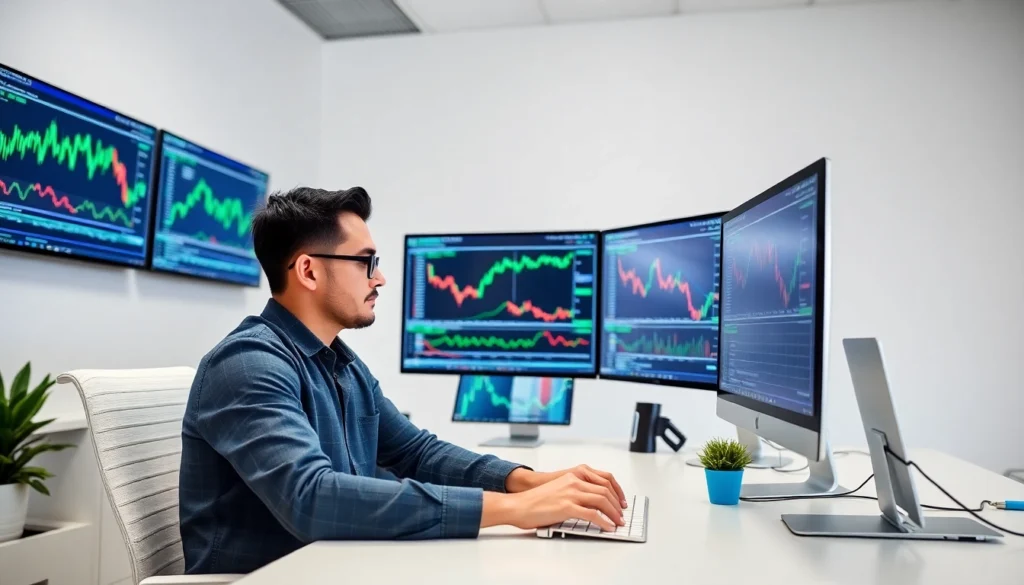Understanding the Fundamentals of Online Trading for Beginners
What Is Online Trading and How Does It Work?
Online trading refers to the process of buying and selling financial instruments—such as stocks, commodities, currencies, and derivatives—via internet-based trading platforms. Unlike traditional trading, which required physical presence at a brokerage office, online trading offers unprecedented accessibility and convenience, allowing individuals to execute trades from anywhere at any time. The core mechanism involves placing orders through brokerage platforms that connect traders directly to financial markets, enabling rapid transactions that are monitored and managed digitally.
This process begins with opening an account through an online broker, funding your account, and then choosing assets to trade based on market analysis or strategic plans. The platform provides real-time data, analytical tools, and order execution services, making online trading a dynamic and fast-paced activity suited for both novice and experienced traders. With bonus features like automated trading, alerts, and tracking tools, online trading facilitates a seamless experience for those looking to grow their investments or generate short-term profits.
In essence, online trading simplifies the traditionally complex process, democratizing access to financial markets and empowering individuals to participate directly in trading activities. For further insights into stock trading, you can visit Online Trading for Beginners.
The Key Terms Every Beginner Must Know
Embarking on your online trading journey requires familiarity with essential terminology. Here are some of the most important terms:
- Bid and Ask: The bid is the highest price a buyer is willing to pay for an asset; the ask is the lowest price a seller is willing to accept.
- Spread: The difference between the bid and ask prices, often representing the broker’s profit margin.
- Market Order: An order to buy or sell immediately at the current market price.
- Limit Order: An order to buy or sell at a specific price or better, giving traders control over entry and exit points.
- Leverage: Borrowed funds used to increase potential returns, which also amplifies risk.
- Liquidity: The ability to buy or sell an asset quickly without causing a significant change in its price.
- Volatility: The degree of variation in the price of an asset over time, indicating risk levels.
- Stop-Loss and Take-Profit: Orders to automatically close a trade to limit losses or lock in profits at predetermined levels.
Common Misconceptions About Online Trading for Beginners
Many newcomers enter online trading with misconceptions that can lead to unrealistic expectations and risky decisions. Some prevalent myths include:
- Quick Riches: Belief that trading offers instant wealth, overlooking the significant risks, learning curve, and the importance of strategic planning.
- Every Trade Will Be Profitable: Assuming continuous profits without understanding market volatility and risk management.
- Trading Is Gambling: While markets can be unpredictable, successful trading is rooted in analysis, discipline, and risk controls, unlike pure speculation.
- More Trades Mean More Profit: Excessive trading without strategy can lead to losses; quality and analysis matter over quantity.
Understanding these misconceptions helps set realistic expectations, enabling a more disciplined and informed approach to online trading for beginners.
2. Setting Up Your First Trading Account: A Beginner’s Guide
Choosing the Right Trading Platform for Beginners
Selecting a suitable trading platform is crucial for building confidence and developing skills. Beginners should prioritize platforms that offer user-friendly interfaces, educational resources, and reliable customer support. Popular options include brokers like Fidelity, Robinhood, eToro, and Moomoo, which provide intuitive designs and comprehensive tools tailored for newcomers.
Features to consider include demo accounts for practice, educational content, trading tutorials, and a suite of analytical tools. Additionally, ensure the platform complies with regulatory standards to safeguard your investments.
Research, compare reviews, and test demo accounts before committing. For example, platforms that integrate educational support like IG Academy or Fidelity’s learning resources can significantly accelerate your learning curve while providing a safe environment to experiment with virtual trading.
How to Open and Fund Your Trading Account
The process begins with selecting a reputable broker and completing the registration by providing personal identification documents for verification. Once your account is approved, you will need to fund it via bank transfer, credit card, or electronic payment methods. Many brokers have minimum deposit requirements, which vary depending on the platform.
After funding, you can set up security measures like two-factor authentication to protect your account. Once your account is active, you’ll be ready to explore trading options, execute your first orders, and implement your trading strategy.
Understanding Brokerage Fees and Account Types
Cost considerations are vital for new traders. Brokers typically charge commissions per trade, spreads, or fees for advanced features. Many platforms now offer commission-free trading, especially for stocks and ETFs, but may charge for options, futures, or margin trading.
Account types include cash accounts and margin accounts, with margin accounts allowing you to borrow funds to leverage trades—but they also carry higher risk. Carefully review fee structures, account features, and regulatory protections. Every trader should aim to minimize costs while ensuring access to the necessary tools for successful trading.
3. Developing Your Trading Strategy and Plan
Analyzing Market Trends and Identifying Trade Opportunities
A fundamental aspect of trading is developing the skill to interpret market trends. Technical analysis involves studying price charts, patterns, and indicators like moving averages, MACD, or RSI to predict future movements. Fundamental analysis focuses on economic data, company earnings, and macroeconomic factors.
Effective traders combine these methods to enhance decision-making, looking for confirmation signals before executing trades. For example, a trader might identify a bullish trend through moving averages and validate with positive earnings reports for a stock.
Risk Management Techniques for Beginners
Managing risk is critical for survival in the markets. Key techniques include setting stop-loss orders to limit potential losses and take-profit levels to secure gains. Diversification spreads risk across multiple assets, reducing exposure to any single position.
Position sizing—determining how much of your capital to risk on each trade—also safeguards against significant losses. Many experts recommend risking no more than 1-2% of your capital per trade. Regularly reviewing trades and maintaining discipline in adhering to your risk parameters are vital for long-term success.
Best Practices for Creating a Trading Plan
A trading plan serves as a roadmap, outlining your goals, risk tolerance, preferred trading strategies, and criteria for entering and exiting trades. It should be based on thorough analysis, backtested strategies, and aligned with your financial situation.
Adherence to the plan prevents impulsive decisions driven by emotions. Keep detailed records of your trades to analyze performance, learn from mistakes, and refine your strategies over time.
4. Executing Your First Trades and Monitoring Performance
Placing Your First Buy and Sell Orders
Start with small, well-researched trades. Use market or limit orders based on your trading plan—market orders for immediate execution, limit orders for precision entry or exit points. Double-check order details before confirmation to prevent costly mistakes.
Access real-time data and remember to consider market hours and liquidity to optimize order execution. Practicing with demo accounts helps build confidence before trading with real capital.
Using Trading Tools and Indicators Effectively
Leverage analytical tools such as candlestick patterns, trend lines, volume analysis, and technical indicators to inform your decisions. Combining multiple signals reduces false positives and improves accuracy.
For beginners, focus on a few reliable indicators and master their interpretation. Many platforms provide tutorials and webinars on effective tool usage.
Evaluating Your Trades and Adapting Strategies
Post-trade analysis involves reviewing your trade outcomes against your plan. Identify what worked, what didn’t, and why. Metrics like win rate, average gain/loss, and risk-reward ratio are valuable performance indicators.
Continuous learning and flexibility are crucial. Adjust your strategies based on market conditions and personal experience to optimize results over time.
5. Advancing Your Skills and Building Confidence in Online Trading
Learning from Trading Simulations and Demo Accounts
Many brokers offer demo accounts where you can practice trading with virtual funds. This safe environment allows you to test strategies, familiarize yourself with platform features, and build confidence without risking real money.
Regular practice helps in developing discipline, understanding order types, and managing emotions—crucial skills for real trading.
Continuing Education Resources for Beginners
Stay informed through online courses, webinars, market news, and trading communities. Reputable sources include broker-provided educational materials, financial news outlets, and specialized platforms like IG Academy or Fidelity’s learning hub.
Engaging with successful traders and mentors can accelerate your learning curve, providing practical insights and personalized guidance.
Tips for Sustaining Long-Term Success in Online Trading for Beginners
Maintain patience, discipline, and emotional control. Aim for consistent performance rather than quick gains. Regularly review your trading journal, refine your strategies, and adapt to changing market conditions.
Manage expectations realistically and accept losses as part of the learning process. Long-term success relies on continuous education, prudent risk management, and psychological resilience.


